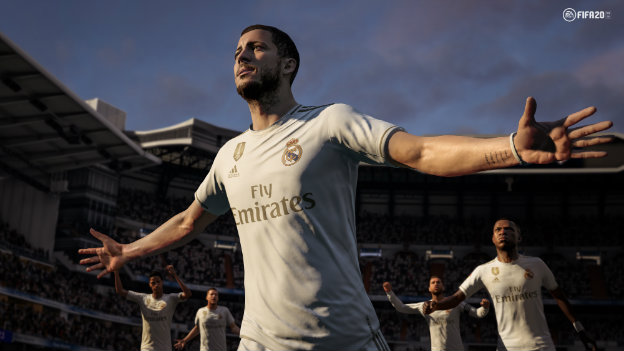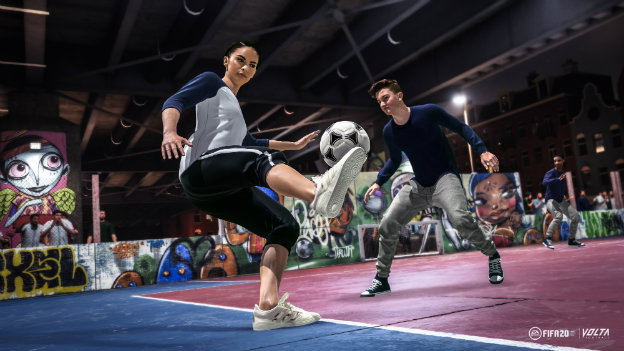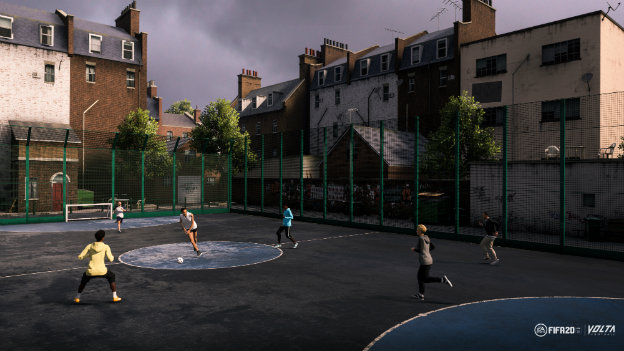Squad Goals
FIFA, like the rest of EA Sports’ catalogue, is a series that gets blasted out on an annual basis, made by the same studio, and is fueled by marginal improvements, random new gameplay modes, and extra feature ideas. Sometimes they work and sometimes they don’t, but with a few exceptions, they don’t often stick around. FIFA stands out, because while it doesn’t get that much attention in some countries, it’s one of EA’s biggest moneymakers due to soccer’s global popularity. That’s caused FIFA to be the center of international legal battles over loot mechanics. But, it also means FIFA can act as the tip of the spear for new foundational work. In years past, FIFA was the starting point for Real Player Motion, EA’s initiative to distinctly update its physics and move everything to the Frostbite engine. With FIFA 20, the team’s goal was a little more insular, as the developers focused on defining FIFA as a space for engaging gameplay.
Despite not being much of a sports fan (save for pro wrestling and Super Mario Strikers), I’ve jumped in the deep end, so to speak, with EA’s annual preview events. I’ve gotten to know each sport in video game terms quite well, but FIFA was my blind spot. That’s mostly because FIFA 19 wasn’t very fun to play, so I sort of avoided it. I could see why soccer enthusiasts would enjoy it by default, but as a video game, it was far too clunky and insular to hop into and have casual fun with. It was a bit too fast, a bit too janky, and could be too reliant on AI over player input. But this year, the team really focused on changing that vibe.
FIFA 20 is much more about dialing back the overall pace and letting the player like they’re making an impact. Part of this is the usual physics tweaks and improvements you’d expect to see in the next game on the conveyor belt. But, the slowed down speed is a huge factor. You can digest what’s happening on the field faster, react to what’s happening more easily, and chase the ball with your eyes and your hands more realistically. In addition to that, the AI on your side is still helpful, but is a bit less aggressive and more in tune with what the human player is doing. Major adjustments have been regarding what happens when the player possessing the ball clashes with an opponent. Animations and hit detection have been improved to make that interaction look more like a fight, and moves like strafing have been added to make one on one confrontations more skill-oriented. And when two players do just run into each other, you can actually see the game doing its math to see who “wins” via those animations.
All of those changes may or may not be “improvements” in the literal sense or in terms of adapting the sport as a simulation. However, it does make FIFA more approachable and more fun to play as a video game. As a piece of software designed to be enjoyable, from the perspective of a person holding the controller, it’s definitely an improvement. Now, while FIFA 20 has a lot going on with its usual modes, such as new casual play options and Fortnite-like objectives in FUT, the real star of the show this year is VOLTA. Similar in design to NHL’s World of Chels last year, VOLTA is a mode that takes FIFA away from, well, FIFA, and onto the streets and other non-league venues. It’s sort of comparable to the FIFA Street of old, but totally different in form and function.

VOLTA lets you build a custom player, using all kinds of different options. These options aren’t bound by gender either, so you can have a big ol’ muscular boy with an extremely well-kempt bob or a lady with a sick fade if you want, and everything in-between. This makes the FIFA character creator fairly inclusive, as far as these things go. You’re still picking male/female, but play in VOLTA is totally intergender and stats aren’t unique based on what you choose. As was explained to me in our FIFA 20 interview, the goal here was diversity and creating a reflection of the real world.
That’s achieved through the various ways you can play VOLTA. It’s not just about building up your own player; it’s about building a squad. When you play against another team, generated either by the game itself or another player, you can recruit new members onto your team. The intent here is to have players end up with squads built by the FIFA community, to build a massive space in which everyone is playing with each other and sharing content. It’s pretty cool and totally open to players of different skill levels and competitive drives.

The other cool thing about VOLTA is how is messes with the traditional soccer gameplay format. There are different configurations you can choose from, from a full suite of players all the way down to one on one. You can play field-only games, meaning the battle on the pitch is even more frantic as neither team gets a dedicated goalkeeper. There are also certain venues, such as the cool nighttime Japanese stadium set on a skyscrape, that feature walls, eliminating out of bounds plays from the equation. Not only that, but the walls actually have the functional properties of players, meaning you can aim at them and bank shots or passes off to get really creative. VOLTA adds a ton of style, color, and flair to the usual FIFA setup, which means there’s an additional layer of accessibility beyond the gameplay tweaks.

FIFA 20 feels like it might be a more divisive entry than usual. In altering the physics and game flow so dramatically, the team risks alienating just as many players as it hopes to bring in. That said, everything that makes FIFA what it is remains intact, with the usual attempts at streamlining and bug-wrangling. VOLTA is the big draw, with its community-driven structures and inclusive character creation. While plenty of fans will no doubt immediately jump to their favorite corners of FIFA, this year’s attempt at trying something new feels almost like its own game. EA Sports has been trying more and more lately to put a little something for everyone in each title, and FIFA 20 does exactly that.
RATING OUT OF 5 RATING DESCRIPTION 4.0 Graphics
Frostbite is pretty 3.0 Control
FIFA 20 is super complicated and requires lots of knowledge and memorization for the full experience, but basic controls are simple 4.0 Music / Sound FX / Voice Acting
There are basic sports game sounds, like licensed music tracks, commentary and ambient game noise. It serves its purpose 4.5 Play Value
Additions of casual-adjacent features and other modes that significantly change structure and rules add plenty of mileage. New objectives systems in FUT do similar work 4.0 Overall Rating – Great
Not an average. See Rating legend below for a final score breakdown.
| Review Rating Legend | |||
|---|---|---|---|
| 0.1 – 1.9 = Avoid | 2.5 – 2.9 = Average | 3.5 – 3.9 = Good | 4.5 – 4.9 = Must Buy |
| 2.0 – 2.4 = Poor | 3.0 – 3.4 = Fair | 4.0 – 4.4 = Great | 5.0 = The Best |
Game Features:
